I have compiled these lists as a help in identifying and understanding the plants along the trails we ride in the Mesquite Nevada area of the Mojave Desert. The book Native Plants of Southern Nevada: an Ethnobotany by David Rhode serves as my guide. This is the cacti section — remember, all cacti are succulents but not all succulents are cacti.
Cacti:
Desert Plants: Succulents | Cacti | Lg. Shrubs | Sm. Shrubs | Herbaceous | Trees
California Barrel Cactus (Ferocactus cylindraceus) [Native American: Biznaga, Bisnaga and Viznaga]:

Ray's Cactus Garden (Mesquite Valley), Spring 08
Middle Canyon, winter 09
[aka compass cactus] These grow on nearly every slope around the area, seeming to prefer angles. The California Barrel is one of many of the "ferocactus" – meaning "fierce or wild," having prominent ribs wich are fiercely armed with heavy spines of varying shapes. The California Barrel grows to 4-8 feet and has dense, light yellow to bright red spines which hides the barrel. There is no pronounced difference between its central and radial spines, but central ones are stouter, curved, ridged, and sometimes hooked. Unlike other plants, the barrel cactus usually grows towards the south (to prevent sunburn), giving rise to the name "compass cactus." It is the last of the cacti to bloom. Flowers appear in Jul-Aug and are orange, red or yellow and produce yellow, fleshy fruit. They grow between 200 and 5,000 feet in California, Arizona, Nevada and Utah.
Besides being a "compass" as described above, the plant had other uses. Spines were used as needles, awls, fish hooks and tatooing. The fruit does become fleshy but is not usually considered edible. Young flowers were boiled in water for a cabbage-like dish, old flowers were mashed after boiling for a drink. When traveling the plant might be topped, hollowed and filled with water and hot-stones as a cooking pot. The barrell is NOT filled with water as per cartoon stories - it's pulp may be chewed to quench thirst but has a peculiar taste making many other cactus pads much more preferrable.
Cottontop Cactus (Echinocactus polycephalus) [S Paiute: "thamave"]:
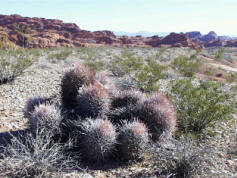
Logandale trail, winter 09, one trunk
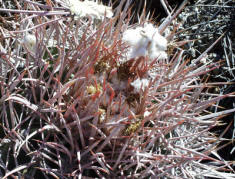
Logandale trail, winter 09, close up of cotton
[aka Clustered Barrel, woolly cactus, woolly-headed cactus, many-headed barrel cactus] This species is a bit rare in the area and a treat when you find them. They grow in clumps of several stems together up to 3 feet in diameter. Much larger than a hedgehog, usually smaller than a barrel, they have a ring of "cotton-like" fibers around the top where flowers once were. They are ribbed with densely clustered, red or yellow spines along them the central spine being the longest at 2-3 inches. Flowering in late summer (latest in the area) they produce yellow/pink, fragrant florets. It's the flower's ovary which becomes woolly and cotton-like and gives the plant its name. It grows throughout the Mojave, below 5000 feet with creosote and shadscale on limestone-derived substrates.
The needles of the plant are sturdy enough to be used as needles or awls. The spine can even be enclosed in a creosote bush handle. The seed can be used for food and the plant can be baked and ground to a powder which was used to treat burns.
Buckhorn Cholla (Cylindropuntia acanthocarpa):
Lime Kiln Cyn, winter 09, closeup
Buckhorn - Although they nearly look alike, these plants live Northern (Nevada/Arizona), and their spines number more than 10, up to 25 per areole, are tan to straw-colored, and the longer ones are up to 1 1/2" long. Their flowers are smaller than Staghorn, and their anthers are dark red. Their fruits fall within a few months and are dry, deeply tuberculated, and covered with numerous long spines.
Staghorn, by contrast, live Southern (California, Arizona and Mexico) and have wider tubercles (> 3 times as long as wide). They have less than 10 spines per areole which are 1/4" to 5/8" long, reddish in color and spread out in all directions. Staghorn flowers tend to be larger than Buckhorn flowers, anthers are NOT red. Staghorn fruit is persistent (more than a year), fleshy and usually spineless.
Golden Cholla (Cylindropuntia echinocarpa) [S Paiute: hintcung arump]:
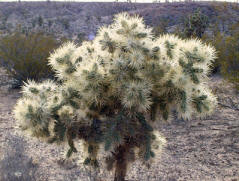
3-Corners (Ut, Az, Nv), winter 09
[aka Silver Cholla and (mistakenly) staghorn cholla] Ubiquitous to the area, it grows 3-4 feet tall and has many short branches, densely covered with golden or brown spines. The spine is nasty because it is covered with a thin removable paper sheath which remains in the skin to fester even after the spine is removed. Elliptical tubercles are, about twice as long as wide (contrast with Buckhorn Cholla, which have long, stretched out tubercles). It produces a lime-green flower which develops a yellow-red fruit that drys and is spiny smelling of rancid-butter. It grows below 5800 feet with creosote, burrobush-wolfberry and sagebrush.
Needles of the plant can be used as "needles" and awls for sewing, basketry and piercing earlobes. The pulp can be scraped out and used as a wet dressing for cuts and wounds to deaden pain and promote healing. The fine furze around the spines was sometimes rubbed into warts or moles for removal. At least one tribe gathered and cooked the newly budding branches into jelly.
Pencil Cholla (Cylindropuntia ramosissima):
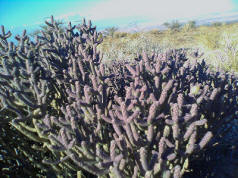
EBF, winter 09
[aka Diamond C., Branched Pencil C.] Quite an uncommon plant in the area it is a pleasant respite from all the Yucca's, Buckhorn's and Golden's. It is a shrub-like cactus with very narrow, pencil thin, stem segments and long, but sparse spines which are solitary rather than in clusters like other cacti. Stems can be green to reddish-brown with a diamond-shaped pattern. Early summer flowers are small, solitary on the stem ends and yellow to red with green filaments. They grow on well-drained, sand-gravel-rocky soils, on flats, bajada and other moderate slopes and around Mesauite at least, seem to prefer somewhat protected areas; hence they are seen only in the Middle Canyon draw on East Bunkerville Flats - and at the local museum.
The fruit of the plant can be used raw, cooked or dried but precautions must be taken for the miniscule, but dangerous spines. Un-ripe fruits can be added to soups to impart an okra-like thickening quality. Seeds can be briefly roasted then ground into a powder. The gum from the stems may used as a masticatory or mixed with oil to make candles. The juice of boiled stem segments is sticky and added to plaster, whitewash etc to make it adhere to walls better.
Pricklypear (Opuntia varied species):
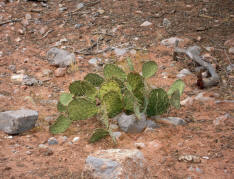
The number of plants in this genus is huge – well over a hundred different, difficult to distinquish, species of
flowering Opuntia's often cultivated as a cash crop. Identification may be hindered by need to see the flowers and blooms.
Those known to the Mojave desert area are:
"Pancake" (chlorotica) has circular, bluish pads; round trunk; upright growth to 7 feet; yellow flowers with red centers; fleshy,
purple-gray fruit.
"Plains" (polycantha) has oval, 3-4 inch, blue-green pads; horizontal growth, 6-12 height; red-orange to yellow
flowers; spiny, 1.5 in fruit.
"Mojave, hedgehog, porcupine" (erinacea) has spiny, 5 inch pads; grows 12-18 inches in height; bright yellow or rose flowers; and
very spiny fruit.
"Low/Smooth" (humifusa) has oval or round, 2-6 inch pads; grows up to 2 feet in height; has yellow with red base flowers;
and pear-shaped, hairless fruit.
"Brown-spined" (phaecantha) has oblong, blue-green, 4-6 inch pads; grows 2-3 feet in height; yellow flowers; and plump, jucy red or
purple fruit.
"Beavertail" (basilaris) has pads shaped like a beaver's tail, gray-green to 13 inches; grows 12-18 inches tall; bright rose,
2-3 inch flowers; and oval, 1.5 inch, gray-brown fruit which are dry at maturity with many seeds.
Beavertail Pricklypear (Opuntia basilaris) [S Paiute: navump, navumpi, navumb]:
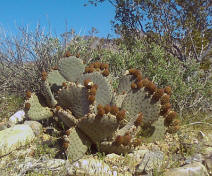
Beavertail Pricklypear, Gold Butte Rd, spring 08
[aka Prickly Pear Beavertail] Fairly common to the area it has very distinctively shaped, dark green to bluish, pads resembling a beaver's tail. It is a low spreading perrenial with flat joints and sports no obvious spines. It does have a reddish-brown furze in small depressions which contain tiny glochids of spines. Its flowers are a brilliant magenta or white and it grows below 5500 feet with crosote, sagebrush and occasionally with pinyon-juniper.
The meaty fruits were sometimes knocked off with a stick and eaten raw; or, they could be dried and stored for year-round eating. They make excellent jelly. The pads were cooked in ashes or rocks to remove the skin by blistering, then the inner pith could be eaten. In an extreme, the fresh pads could be peeled and chewed for water. Dried pads can be scraped and boiled with salt to eat. The blossoms were eaten and the prickly fuzz from the pads was rubbed into warts. Native peoples were known to have transplanted and husbanded the cactus.
Mojave Pricklypear (Opuntia erinacea):
[AKA grizzlybear, Hedgehog, Porcupine] This species is less common in the area and seems to prefer more secluded, less dry and less hot desert areas than others of its kind. It develops oval or oblong joints covered with long, shaggy appearing, more flexible brown or white spines. The fruit is even spined and flowers are commonly yellow to bronze but occasionally are found with reddish-purple flowers. It grows on gravelly slopes with blackbrush, sagebrush and pinyon-juniper between 3700 and 7200 feet.
The fruits can be eaten fresh and roasted, made into a jam and wine or dried and stored for year-round consumption.
Hedgehog (Echinocereus engelmannii) [S Paiute: wisuyuavimpi, "hu-siv-vich"]:
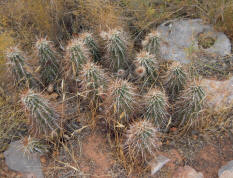
This plant grows in dense clusters and is columnar or elongated, growing up to 2 feet tall. Eash stem is 2-5 inches in diameter with ten to thirteen prominent ribs, vertically along the trunk. Spines grow along the ribs and are often quite long, numerous and multicolored. The main spine can measure up to 3 inches in length. Flowers are sort of funnel shaped (like a crocus) are rose to lavender in color and up to 3 inches in diameter. The fruit is fleshy, red, and edible - some species are said to taste like strawberries. It grows below about 6600 feet in desert shrub communitites.
Fruit was gathered by native people in the late summer for fresh eating, but it could also be cooked or dried. It is still used today for fresh eating.
Mojave Mound (Echinocereus mojavensis):
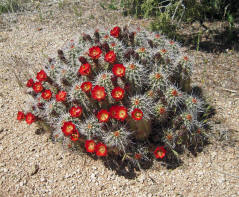
[aka Mojave Kingcup Cactus]. Probably the most beautiful cactus on "the Butte" in the spring and is not very common, in fact fairly isolated and rare. As a "hedgehog" it is a closely packed mound of several stems nearly always shorter than about 1-foot tall. They are covered with gray, twisted and interlocking spines and the early spring flowers are a burgundy like red. The plant doesn't bloom all at once but seems to progress across its segments from the side facing the sun.
Desert Plants: Succulents | Cacti | Lg. Shrubs | Sm. Shrubs | Herbaceous | Trees